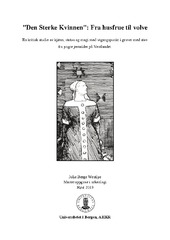"Den Sterke Kvinnen": Fra husfrue til volve - En kritisk studie av kjønn, status og magi med utgangspunkt i graver med stav fra yngre jernalder på Vestlandet.
Master thesis
Permanent lenke
https://hdl.handle.net/1956/21267Utgivelsesdato
2019Metadata
Vis full innførselSamlinger
- Master theses [207]
Sammendrag
The idea that metal staffs represent one of the main tools for female ritual specialist in the Viking age, is mostly accepted in modern archaeology. This idea has also been solidified in the mind of the public through multiple museum exhibitions displaying these objects within the context of past ritual practice. Research focusing on seid has argued that magic was women’s work, and that ritual specialist existed on the fringes of society. This thesis sets out to review the way gender as a research category is applied to studies on seid and magic, and more specifically what this ends up saying about persons buried with staffs. I argue that we cannot discuss gender in prehistoric society, without also reflecting on gender ideology, both in the past and in the presence. Limiting the focus of this study to graves containing staffs of Bøgh-Andersens type III from Western Norway, the thesis intends to show how different persons in different local contexts expressed their identities in varying ways. Grounded in a theoretical framework composed of feminist theories and influences from Fowlers theories on personhood, I argue that identity is intersectional and relational. Through detailed analysis of grave goods, this thesis concludes that gender is not always clearly cited in the graves containing staffs. Contrasting with popular belief, some of the graves are shown to exclusively reference a traditional masculine role. Some objects found in the graves containing staffs may indicate an association to pre-Christian faith or possibly magic. However, the most prevalent common aspect of pre-Christian belief expressed through these burials is a wish to connect with ancestors and to maintain a relationship with farm and kin. In this sense I argue that the people buried with staffs in Western Norway during the Viking Age were not situated on the fringes of society, rather they were active participants in their community. It may be argued that people buried with staffs were associated with the practice of magic, but they must also have taken on other roles through their lifetimes. All these differing social roles may be visible in the grave assemblages containing staffs in varying ways and neither gender nor magic is necessarily the primary aspect of identity cited in all contexts.
